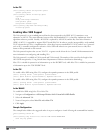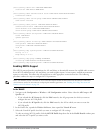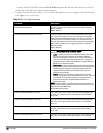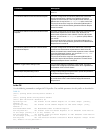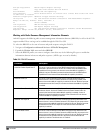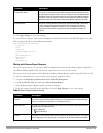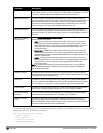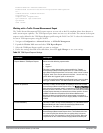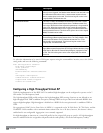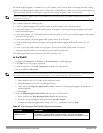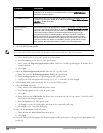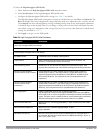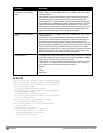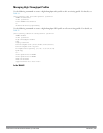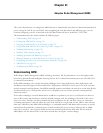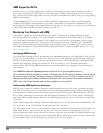
340 | VirtualAPs DellPowerConnectW-SeriesArubaOS6.2 | User Guide
Parameter Description
frame is set to "triggered", the Randomization Interval is not used and is set
to 0. A Randomization Interval of 0 in a measurement request indicates
that no random delay is to be used. This field can be given a value in the
range (0, 65535). The default value is 0.
Measurement Duration This value is used to set the Measurement Duration field in the Transmit
Stream/Category Measurement Request frame. The Measurement Dura-
tion is set to the duration of the requested measurement. It is expressed in
units of TUs. When the request mode for the Transmit Stream/Category
Measurement Request frame is set to "triggered", the Measurement Dura-
tion field should be set to 0. This field can be given a value in the range (0,
65535). The default value is 9776.
Traffic ID
The value is used to set the Traffic Identifier field in the Transmit
Stream/Category Measurement Request frame. The Traffic Identifier field
contains the TID subfield. The TID subfield indicates the TC or TS for
which traffic is to be measured. This field can be given a value in the
range (0, 255). The default value is 96
Bin 0 Range This value is used to set the 'Bin 0 Range' field in the Transmit Stream/Cat-
egory Measurement Request frame. Bin 0 Range indicates the delay range
of the first bin (Bin 0) of the Transmit Delay Histogram, expressed in units
of TUs. This field can be given a value in the range (0, 255). The default
value is 6.
To select the information to be sent in TSM report requests using the command-line interface, access the CLIin
config mode and issue the following commands.
wlan tsm-req-profile <default>
bin0-range <bin0-range>
clone <prfoile>
dur-mandatory
measure-duration <measure-duration>
no
num-repeats <num-repeats>
random-interval <random-interval>
request-mode normal|triggered
traffic-id <traffic-id>
Configuring a High-Throughput Virtual AP
With the implementation of the IEEE 802.11n standard, high-throughput can be configured to operate on the 5
GHz and/or 2.4 GHz frequency band.
The high-throughput SSID profile configures the high-throughput SSID settings. Stations are not allowed to use
high-throughput with TKIP standalone encryption, although TKIP can be provided in mixed-mode BSSIDs that
support high-throughput. High-throughput is disabled on a BSSID if the encryption mode is standalone TKIP or
WEP.
De-aggregation of MAC Service Data Units (A-MSDUs) is supported on the W-3000 Series, W-7200 Series, and the
W-6000M3 Dell controllers with a maximum frame transmission size of 4k bytes; however, this feature is always
enabled and is not configurable. Aggregation is not currently supported.
For high-throughput to function on a virtual AP profile for the assigned AP group or specific AP, high-throughput
must be enabled within the assigned ht-ssid-profile and the radio-profile(s) for the desired frequency band(s).



